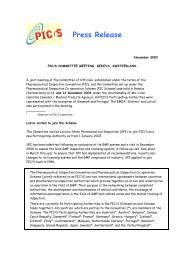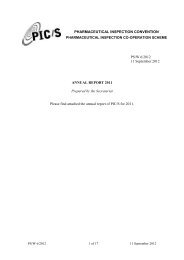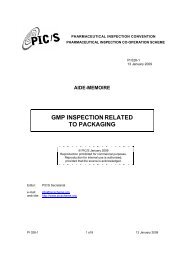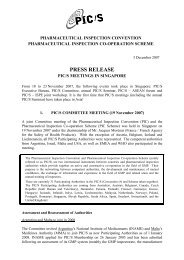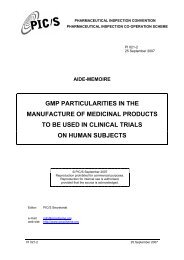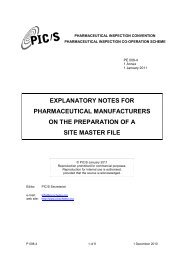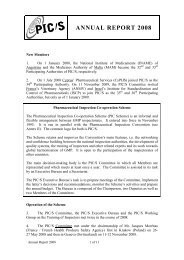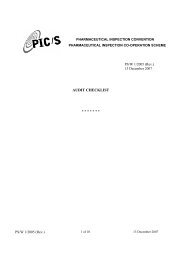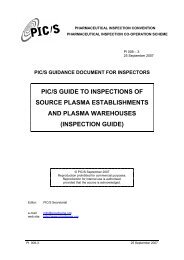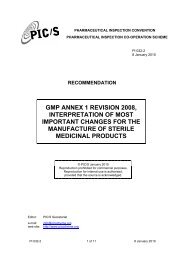PI 012-3 Recommendation on Sterility Testing - PIC/S
PI 012-3 Recommendation on Sterility Testing - PIC/S
PI 012-3 Recommendation on Sterility Testing - PIC/S
- No tags were found...
Create successful ePaper yourself
Turn your PDF publications into a flip-book with our unique Google optimized e-Paper software.
PHARMACEUTICAL INSPECTION CONVENTIONPHARMACEUTICAL INSPECTION CO-OPERATION SCHEME<str<strong>on</strong>g>PI</str<strong>on</strong>g> <str<strong>on</strong>g>012</str<strong>on</strong>g>-325 September 2007RECOMMENDATIONONSTERILITY TESTING© <str<strong>on</strong>g>PI</str<strong>on</strong>g>C/S September 2007Reproducti<strong>on</strong> prohibited for commercial purposes.Reproducti<strong>on</strong> for internal use is authorised,provided that the source is acknowledged.Editor:e-mail:web site:<str<strong>on</strong>g>PI</str<strong>on</strong>g>C/S Secretariatinfo@picscheme.orghttp://www.picscheme.org<str<strong>on</strong>g>PI</str<strong>on</strong>g> <str<strong>on</strong>g>012</str<strong>on</strong>g>-3 25 September 2007
TABLE OF CONTENTSPage1. Document history.............................................................................................. 12. Introducti<strong>on</strong>....................................................................................................... 13. Purpose ............................................................................................................ 14. Scope................................................................................................................ 14.1 Inclusi<strong>on</strong>s.......................................................................................................... 14.2 Exclusi<strong>on</strong>s ........................................................................................................ 15. Definiti<strong>on</strong>s......................................................................................................... 26. Background ...................................................................................................... 27. Training............................................................................................................. 38. <strong>Sterility</strong> test facilities ......................................................................................... 38.1 Clean room design ........................................................................................... 38.2 Airlock and aseptic gowning............................................................................. 48.3 Clean room fittings and surfaces...................................................................... 59. Cleaning, sanitisati<strong>on</strong> and disinfecti<strong>on</strong>............................................................. 510. Envir<strong>on</strong>mental m<strong>on</strong>itoring................................................................................. 511. <strong>Sterility</strong> test details............................................................................................ 611.1 Sampling........................................................................................................... 611.2 Test methodology............................................................................................. 711.3 Media types and manufacture.......................................................................... 711.4 Incubati<strong>on</strong> period.............................................................................................. 711.5 Negative test c<strong>on</strong>trols....................................................................................... 811.6 Positive test c<strong>on</strong>trols......................................................................................... 812. Results............................................................................................................ 1013. Interpretati<strong>on</strong> and repeat tests ....................................................................... 1014. References ..................................................................................................... 1115. Revisi<strong>on</strong> history .............................................................................................. 11<str<strong>on</strong>g>PI</str<strong>on</strong>g> <str<strong>on</strong>g>012</str<strong>on</strong>g>-3 - i - 25 September 2007
1. DOCUMENT HISTORYAdopti<strong>on</strong> by Committee 7 September 1999Entry into force of PE 001-1 1 January 2000Entry into force of <str<strong>on</strong>g>PI</str<strong>on</strong>g> <str<strong>on</strong>g>012</str<strong>on</strong>g>-1 1 November 20022. INTRODUCTIONInspecti<strong>on</strong> of sterility testing facilities and test methodology used by laboratories performingthe sterility test for batch release of pharmaceutical products is included in the qualityc<strong>on</strong>trol activities checked by GMP inspectors.3. PURPOSEThe purpose of this document is to provide guidance for GMP inspectors to use for trainingpurposes and in preparati<strong>on</strong> for inspecti<strong>on</strong>s in order to promote a c<strong>on</strong>sistent and thoroughapproach in all aspects of sterility testing.4. SCOPE4.1 INCLUSIONS4.1.1 The sterility test that is performed either by the manufacturer or its c<strong>on</strong>tracttesting laboratory <strong>on</strong> the finished product as a batch release quality c<strong>on</strong>trol testis specified in this document. The recommendati<strong>on</strong>s in this document are based<strong>on</strong> the requirements of clause 2.6.1 <strong>Sterility</strong> described in the EuropeanPharmacopoeia, Third Editi<strong>on</strong>, Supplement 1998 1 and revised by RapidImplementati<strong>on</strong>, Resoluti<strong>on</strong> AP.CSP(98)6, which was promulgated <strong>on</strong>1 September 1998.4.1.2 At the time of issue this document reflected the current state of the art. It is notintended to be a barrier to technical innovati<strong>on</strong> or the pursuit of excellence.However, your nati<strong>on</strong>al legislati<strong>on</strong> should always be referred to whendetermining the extent to which the provisi<strong>on</strong>s laid down in this document arebinding. This document should be used for <str<strong>on</strong>g>PI</str<strong>on</strong>g>C/S related inspecti<strong>on</strong>s. Theadvice in this recommendati<strong>on</strong> is not mandatory for industry. However, industryshould c<strong>on</strong>sider <str<strong>on</strong>g>PI</str<strong>on</strong>g>C/S recommendati<strong>on</strong>s as appropriate.4.2 EXCLUSIONSA product batch release test that relies <strong>on</strong> the sterility of a biological indicator, althoughoften referred to as a "sterility test" by some manufacturers, is not c<strong>on</strong>sidered to be asterility test and is not described in this document.<str<strong>on</strong>g>PI</str<strong>on</strong>g> <str<strong>on</strong>g>012</str<strong>on</strong>g>-3 Page 1 of 11 25 September 2007
5. DEFINITIONSFor the purposes of this document, the following definiti<strong>on</strong>s apply:5.1 col<strong>on</strong>y forming unit (CFU): Visible outcome of growth of micro-organismsarising from a single or multiple cells.5.2 growth promoti<strong>on</strong> test: Also referred to as fertility or nutritive properties test,which is performed <strong>on</strong> the media used during the sterility test to dem<strong>on</strong>stratethat it is capable of supporting the growth of micro-organisms.5.3 negative c<strong>on</strong>trols: Refers to the sterility test c<strong>on</strong>trols that may be used toidentify a "false positive" test result. Growth in the media sterility test, orenvir<strong>on</strong>mental m<strong>on</strong>itoring, or negative product c<strong>on</strong>trols may c<strong>on</strong>tribute to theverificati<strong>on</strong> of a "false positive" test finding and an invalid test result.5.4 negative product c<strong>on</strong>trols: Product or simulated product of known orundoubted sterility that is tested during the same test sessi<strong>on</strong> as the product testsamples. Negative product c<strong>on</strong>trols should be exposed to a terminal sterilisati<strong>on</strong>process, such as exposure to steam sterilisati<strong>on</strong>, gamma-irradiati<strong>on</strong> etc, and bepackaged in a similar manner to the test sample in terms of manipulati<strong>on</strong>srequired of the test operator.5.5 positive c<strong>on</strong>trols: Refers to the sterility test c<strong>on</strong>trols that may be used to definea "false negative" test result. An absence of growth of test challenge microorganismsin the growth promoti<strong>on</strong>, validati<strong>on</strong> or "stasis" tests would result in a"false negative" test finding and an invalid test result.5.6 stasis test: Also referred to as an inhibiti<strong>on</strong> test, which is performed to ensurethat there are no inhibitory substances remaining in the product and that themedia is still capable of supporting the growth of micro-organisms at the end ofthe sterility test incubati<strong>on</strong> period. This test is not mandatory but it may beuseful to c<strong>on</strong>firm the inactivati<strong>on</strong> of antimicrobial substances in products wherea marginal test methodology is employed routinely, after an initial successful testvalidati<strong>on</strong>.5.7 validati<strong>on</strong> test: Also referred to as a bacteriostasis and fungistasis test, whichis performed in the presence of the product to determine whether inhibitoryproperties in the product have been neutralised at the beginning of the sterilitytest incubati<strong>on</strong> period.6. BACKGROUND6.1 Although "sterility" is an absolute term, the assurance that any given item issterile is a probability functi<strong>on</strong>, comm<strong>on</strong>ly expressed as a negative power to thebase ten. The minimum acceptable <strong>Sterility</strong> Assurance Level (SAL) forterminally sterilised drugs is generally based <strong>on</strong> the probability of a n<strong>on</strong>-sterileunit of 10 -6 .6.2 In practice, the sterility of a product is defined by the absence of viable andactively multiplying micro-organisms when tested in specified culture media.Turbidity in the broth media usually indicates c<strong>on</strong>taminati<strong>on</strong>. This test is<str<strong>on</strong>g>PI</str<strong>on</strong>g> <str<strong>on</strong>g>012</str<strong>on</strong>g>-3 Page 2 of 11 25 September 2007
performed <strong>on</strong> the end-product and is <strong>on</strong>e of the quality c<strong>on</strong>trol tests specified forrelease of a batch of sterile product. The sterility test cannot be used todem<strong>on</strong>strate the sterility of the entire batch but it may assist in identifying a n<strong>on</strong>sterilebatch of product.6.3 It is acknowledged that the sterility test suffers from significant statisticallimitati<strong>on</strong>s and this c<strong>on</strong>tributes to the low probability of detecting anything lessthan gross c<strong>on</strong>taminati<strong>on</strong>. However, these limitati<strong>on</strong>s can be reducedc<strong>on</strong>siderably by performance of the test under c<strong>on</strong>diti<strong>on</strong>s that optimise therecovery of micro-organisms.7. TRAINING7.1 <strong>Sterility</strong> testing should <strong>on</strong>ly be performed by pers<strong>on</strong>nel who have been trained,qualified and certified to perform the various tasks and procedures related tosterility testing. The examinati<strong>on</strong> of test and c<strong>on</strong>trol c<strong>on</strong>tainers during and at theend of the incubati<strong>on</strong> period should be included as part of the operator trainingprogram.7.2 Supervisors should ensure that all pers<strong>on</strong>nel are m<strong>on</strong>itored and follow StandardOperating Procedures (SOPs). Pers<strong>on</strong>nel should undergo periodic recertificati<strong>on</strong>,particularly when problems are detected during the course ofroutine envir<strong>on</strong>mental and negative c<strong>on</strong>trol m<strong>on</strong>itoring, or when operatorsperform the test infrequently.7.3 Pers<strong>on</strong>nel training should be documented and records maintained.8. STERILITY TEST FACILITIESThe <str<strong>on</strong>g>PI</str<strong>on</strong>g>C/S Annex to the Guide to Good Manufacturing Practice for Medicinal Products -Manufacture of Sterile Medicinal Products 2 specifies requirements that are also applicableto the inspecti<strong>on</strong> of sterility testing facilities. The recommendati<strong>on</strong>s in Secti<strong>on</strong> 8 of thisdocument are applicable to the performance of the sterility test in a standard clean roomenvir<strong>on</strong>ment. <str<strong>on</strong>g>Recommendati<strong>on</strong></str<strong>on</strong>g>s involving the use of isolator technology for sterility testingare provided in the <str<strong>on</strong>g>PI</str<strong>on</strong>g>C/S Isolators used for Aseptic Processing and <strong>Sterility</strong> <strong>Testing</strong> 3document.8.1 CLEAN ROOM DESIGN<strong>Sterility</strong> testing should be performed under aseptic c<strong>on</strong>diti<strong>on</strong>s, which are preferablyc<strong>on</strong>sistent with the standard of clean room required for the aseptic manufacture ofpharmaceutical products. Premises and equipment should be qualified according to therelevant principles of Installati<strong>on</strong> Qualificati<strong>on</strong> and Operati<strong>on</strong>al Qualificati<strong>on</strong> (IQ/OQ).8.1.1 Classificati<strong>on</strong>8.1.1.1 The sterility test should be c<strong>on</strong>ducted within a class A laminar airflow cabinetlocated within a class B clean room, or in an isolator that need not be locatedwithin a c<strong>on</strong>trolled envir<strong>on</strong>ment. The test may also be performed within a classA clean room, if available. <strong>Sterility</strong> testing should be carried out in a work z<strong>on</strong>ethat offers sufficient space and material should be placed in such a way that itdoes not disrupt the laminar airflow.<str<strong>on</strong>g>PI</str<strong>on</strong>g> <str<strong>on</strong>g>012</str<strong>on</strong>g>-3 Page 3 of 11 25 September 2007
8.1.1.2 The test envir<strong>on</strong>ment, which includes the laminar airflow cabinet or isolator,should be certified at least annually by a competent pers<strong>on</strong> for compliance withthe specified standard c<strong>on</strong>diti<strong>on</strong>s.8.1.2 Air supply8.1.2.1 Air supplied to the envir<strong>on</strong>ment should be provided through terminal HEPAfilters, which should be fitted with audible and/or visual alarms to indicate anysustained, out of specificati<strong>on</strong> pressure differentials across the HEPA filters.8.1.2.2 There should be a pressure differential of not less than 10 to 15 Pascals(guidance value) between each of the areas, i.e. ambient/airlock and airlock/testroom. Pressure readings should be taken and recorded from externally mountedgauges unless a validated c<strong>on</strong>tinuous m<strong>on</strong>itoring system is installed. As aminimum, readings should be taken prior to operator entry to the test suite.Pressure gauges should be labelled to indicate the area served, the acceptablespecificati<strong>on</strong>, and whether or not the reading is absolute or differential.8.2 AIRLOCK AND ASEPTIC GOWNING8.2.1 Airlock c<strong>on</strong>diti<strong>on</strong>s8.2.1.1 Entry to the clean room should be via an airlock in which operators are requiredto change into clean room garments.8.2.1.2 The airlock should be designed to facilitate movement of the operator betweenthe relatively unclean and clean areas of the room without compromising theaseptic gowning procedure. A step-over bench is a suitable divisi<strong>on</strong> betweenthese areas.8.2.1.3 The airlock should c<strong>on</strong>tain: a full-length wall mirror; gowning instructi<strong>on</strong>s; handwashing, disinfecti<strong>on</strong> and drying facilities. If clean room garments are stored inthe airlock, then adequate and appropriate storage facilities should be provided.8.2.2 Aseptic gowning8.2.2.1 The sterility test operator should change into sterile clean room garmentsc<strong>on</strong>sisting of a <strong>on</strong>e-piece coverall suit, head cover, beard cover (if applicable),overshoes, gloves and mask. The use of sanitised garments may be acceptableif the process has been validated and their use is not routinely used to justify theperformance of repeat sterility tests.8.2.2.2 Protective garments should be changed for each work sessi<strong>on</strong> or at least <strong>on</strong>ce aday if justified from the results of microbiological m<strong>on</strong>itoring and validati<strong>on</strong>studies.8.2.2.3 Records should be kept of the sterilisati<strong>on</strong> or sanitisati<strong>on</strong> of the garments. Thisrecord may be in the form of a certificati<strong>on</strong> from an external supplier of sterileclean room garments provided that they have been approved by the sterilitytesting laboratory.8.2.2.4 Each operator should be trained and certified in gowning procedures withtraining records maintained.<str<strong>on</strong>g>PI</str<strong>on</strong>g> <str<strong>on</strong>g>012</str<strong>on</strong>g>-3 Page 4 of 11 25 September 2007
8.3 CLEAN ROOM FITTINGS AND SURFACES8.3.1 All fittings, such as power outlets and light fittings should be flush with the wall orceiling surfaces and sealed to prevent entrainment of unclean air. Surfacesshould be smooth and impervious to the cleaning agents used.8.3.2 The joints between ceiling/walls/floor should be coved to facilitate cleaning.8.3.3 If supplied, intercom or communicati<strong>on</strong> systems should be designed to allowhands-free use, or their design should facilitate disinfecti<strong>on</strong>.8.3.4 Chairs, storage cabinets and trolleys should be designed to facilitate cleaningand be suitable for use in a clean room envir<strong>on</strong>ment.8.3.5 There should be no extraneous equipment within the clean room envir<strong>on</strong>ment.8.3.6 Ultraviolet lamps may be fitted within pass-through cabinets <strong>on</strong>ly. Where thereis more than <strong>on</strong>e parallel tube, they should be shielded from each other andchecked at least annually for performance, or whenever new lamps are fitted.9. CLEANING, SANITISATION AND DISINFECTION9.1 Outer surfaces of samples and equipment entering the testing suite should bedisinfected, preferably with a sporicidal agent. Disinfecti<strong>on</strong> of surfaces andsample c<strong>on</strong>tainers should be carried out in such a way as to avoid adventitiousc<strong>on</strong>taminati<strong>on</strong> of the samples by the chemical agent. Therefore, disinfectantsshould be free of microbiological c<strong>on</strong>taminati<strong>on</strong>, which may be achieved throughaseptic filtrati<strong>on</strong> or use of a product-compatible terminal sterilisati<strong>on</strong> method.9.2 Surfaces and operators' gloved hands should be disinfected regularly during thetest sessi<strong>on</strong>.9.3 There should be protocols to cover all daily, weekly, and periodic cleaning,sanitisati<strong>on</strong>, disinfecti<strong>on</strong> and fumigati<strong>on</strong> procedures used in the testingenvir<strong>on</strong>ment. If an isolator is used, the method of disinfecti<strong>on</strong> or sterilisati<strong>on</strong>should be specified.9.4 Prior to implementati<strong>on</strong>, all cleaning, sanitising and disinfecting proceduresshould be validated from a microbiological perspective with respect to minimumdisinfectant c<strong>on</strong>tact times and efficacy. Cleaning and disinfecting agents shouldbe purchased to agreed and documented specificati<strong>on</strong>s.9.5 Records should be retained in respect of routine preparati<strong>on</strong> of cleaning anddisinfecting agents, directi<strong>on</strong>s for their use, and validati<strong>on</strong> of their efficacy.10. ENVIRONMENTAL MONITORING10.1 Envir<strong>on</strong>mental microbiological m<strong>on</strong>itoring should include a combinati<strong>on</strong> of airand surface sampling methods, such as:active air sampling;settle (exposure) plates;<str<strong>on</strong>g>PI</str<strong>on</strong>g> <str<strong>on</strong>g>012</str<strong>on</strong>g>-3 Page 5 of 11 25 September 2007
surface c<strong>on</strong>tact (RODAC) plates, swabs or flexible films;operators' gloved hand plates.10.2 Envir<strong>on</strong>mental m<strong>on</strong>itoring should be performed under operati<strong>on</strong>al (dynamic)c<strong>on</strong>diti<strong>on</strong>s either within the isolator or in the laminar airflow and associatedbackground areas.10.3 Locati<strong>on</strong> maps, exposure durati<strong>on</strong>, and frequency of all types of microbiologicalenvir<strong>on</strong>mental m<strong>on</strong>itoring should be specified in written procedures.10.4 The media used for each type of m<strong>on</strong>itoring should be specified and therecovery of micro-organisms <strong>on</strong> the chosen media should be validated. Suitableinactivators of disinfectants and cleaning soluti<strong>on</strong>s may need to be incorporatedinto recovery media used for samples taken from surfaces.10.5 There should be written specificati<strong>on</strong>s, including appropriate alert and acti<strong>on</strong>limits for microbial c<strong>on</strong>taminati<strong>on</strong>. Guidance limits for microbiologicalenvir<strong>on</strong>mental m<strong>on</strong>itoring of clean rooms in operati<strong>on</strong> may be found in <str<strong>on</strong>g>PI</str<strong>on</strong>g>C/SSterile Annex 2 .10.6 Records should be maintained of the numbers and type of organisms isolatedand results presented in a format that facilitates early detecti<strong>on</strong> of trends.Routine identificati<strong>on</strong> of envir<strong>on</strong>mental micro-organisms to at least the genuslevel should assist in detecting trends. Sensitive techniques such as moleculartyping techniques will be required for identificati<strong>on</strong> of micro-organisms ifequivalence of identity of envir<strong>on</strong>mental and test isolates is the sole rati<strong>on</strong>aleused to invalidate the original sterility test (refer to clause 13.1).11. STERILITY TEST DETAILS11.1 SAMPLING11.1.1 The number of c<strong>on</strong>tainers tested per batch and quantity tested from eachc<strong>on</strong>tainer should be, as a minimum, in accordance with the pharmacopoeialmethod followed.11.1.2 Samples from aseptic fills should be selected from at least the beginning, middleand end of the batch fill. Additi<strong>on</strong>ally, SOPs should define criteria for inclusi<strong>on</strong>and collecti<strong>on</strong> of samples immediately after interrupti<strong>on</strong>s and operatorinterventi<strong>on</strong>s during the filling process.11.1.3 Samples from terminal sterilisati<strong>on</strong> cycles should be selected from at least thepotentially coolest part of the load if such a locati<strong>on</strong> was identified duringvalidati<strong>on</strong> studies, and from every load sterilised.11.1.4 If an original test is declared invalid, then any samples used for the repeatsterility test should reflect the original samples in terms of sampling locati<strong>on</strong>s oraseptic processing times.<str<strong>on</strong>g>PI</str<strong>on</strong>g> <str<strong>on</strong>g>012</str<strong>on</strong>g>-3 Page 6 of 11 25 September 2007
11.2 TEST METHODOLOGY11.2.1 The test methodology should be in accordance with the pharmacopoeial methodused. Membrane filtrati<strong>on</strong> of the product, with either an open or a closed system,is the preferred sterility test methodology. The filter should be pre-wetted,particularly when small volumes and antibiotics are tested. Filtrati<strong>on</strong> of theproduct should be followed by the minimum number of washes of the membranewith a suitable rinsing fluid established during validati<strong>on</strong> studies. The membraneshould not be permitted to dry out between filtrati<strong>on</strong> steps.11.2.2 If the product cannot be filtered, then direct inoculati<strong>on</strong>, immersi<strong>on</strong>, in-situincubati<strong>on</strong> or combinati<strong>on</strong> methods as appropriate are acceptable.11.3 MEDIA TYPES AND MANUFACTURE11.3.1 The media used should be in accordance with the pharmacopoeial methodfollowed. Soya-bean casein digest (SCD) and fluid thioglycollate media (FTM)should normally be used. Alternative media are permitted and may beappropriate if the nature of the product or method of manufacture could result inthe presence of fastidious organisms (e.g. vaccines, blood products, etc).Validati<strong>on</strong> studies should dem<strong>on</strong>strate that alternative media are capable ofsupporting the growth of a wide range of micro-organisms. Inactivators ofantimicrobials may be incorporated into growth media or rinse soluti<strong>on</strong>s asindicated by validati<strong>on</strong> studies.11.3.2 Media should be purchased from an approved supplier, or prepared in-houseaccording to standard operating procedures that are based <strong>on</strong> validatedsterilisati<strong>on</strong> processes. pH checks of media should be included in theseprocedures to ensure that the pH is within specificati<strong>on</strong>s at the time of use.11.3.3 A batch number and a shelf-life should be assigned to all media and batchmanufacturingdocumentati<strong>on</strong> should be maintained.11.4 INCUBATION PERIOD11.4.1 All test c<strong>on</strong>tainers should be incubated at temperatures specified by thepharmacopoeial method for each test media for at least 14 days, regardless ofwhether filtrati<strong>on</strong> or direct inoculati<strong>on</strong> test methodology is used.11.4.2 The temperature of incubators should be m<strong>on</strong>itored and there should be recordsof calibrati<strong>on</strong> of the temperature m<strong>on</strong>itoring devices.11.4.3 Test c<strong>on</strong>tainers should be inspected at intervals during the incubati<strong>on</strong> periodand these observati<strong>on</strong>s recorded.11.4.4 If the product produces a suspensi<strong>on</strong>, flocculati<strong>on</strong> or deposit in the media,suitable porti<strong>on</strong>s (e.g. 2-5 percent) of the c<strong>on</strong>tents of the c<strong>on</strong>tainers should betransferred to fresh media under clean room c<strong>on</strong>diti<strong>on</strong>s, after 14 days, and reincubatedfor a further 7 days.<str<strong>on</strong>g>PI</str<strong>on</strong>g> <str<strong>on</strong>g>012</str<strong>on</strong>g>-3 Page 7 of 11 25 September 2007
11.5 NEGATIVE TEST CONTROLS11.5.1 Media sterility test11.5.1.1 All media should be pre-incubated for 14 days at appropriate test temperaturesto dem<strong>on</strong>strate sterility prior to use. Alternatively, this c<strong>on</strong>trol test may bec<strong>on</strong>ducted c<strong>on</strong>currently with the product sterility test. Media sterility testing mayinvolve either a representative porti<strong>on</strong> or 100 percent of the batch.11.5.1.2 Parametric release of sterile product may be approved by the competentauthority according to clause 5.1.1. Methods of Preparati<strong>on</strong> of Sterile Productsof the European Pharmacopoeia 1 . The c<strong>on</strong>cept of parametric release could beextended to sterility test media that has been terminally sterilised to provide anequivalent level of sterility assurance to that expected for parametric release ofsterile product. In this case, media sterility testing is not required.11.5.2 Negative product c<strong>on</strong>trols11.5.2.1 Negative product c<strong>on</strong>trols, which are similar in type and packaging to the actualproduct under test, should be included in each test sessi<strong>on</strong>. These c<strong>on</strong>trolsfacilitate the interpretati<strong>on</strong> of test results, particularly when used to declare a testinvalid because of c<strong>on</strong>taminati<strong>on</strong> in the negative product c<strong>on</strong>trols.11.5.2.2 A minimum of ten negative product c<strong>on</strong>trol c<strong>on</strong>tainers may be adequate tosimulate manipulati<strong>on</strong>s by the operator during a membrane filtrati<strong>on</strong> test. Anequivalent number of samples to the test samples may be necessary to simulatethe manipulati<strong>on</strong>s of the product by the operator/s during a direct inoculati<strong>on</strong>test.11.5.2.3 The negative c<strong>on</strong>trol c<strong>on</strong>taminati<strong>on</strong> rate should be calculated and recorded.11.6 POSITIVE TEST CONTROLSAll positive c<strong>on</strong>trol tests in this secti<strong>on</strong> use viable challenge micro-organisms.These tests should be c<strong>on</strong>ducted in a laboratory envir<strong>on</strong>ment separate fromeither the isolator or aseptic area where the product is tested.11.6.1 Growth promoti<strong>on</strong> test11.6.1.1 Challenge organism strains that are used to verify the fertility of each batch ofstandard test media should be selected from those reference strains specifiedby the pharmacopoeial method. Envir<strong>on</strong>mental or fastidious organisms may beused if alternative n<strong>on</strong>-selective enrichment media have been selected for thesterility test.11.6.1.2 Media purchased from external vendors should be accompanied by certificati<strong>on</strong>of the growth promoti<strong>on</strong> test performed <strong>on</strong> each batch of media. The test neednot be repeated by the sterility testing laboratory provided there is documentedc<strong>on</strong>trol over the c<strong>on</strong>diti<strong>on</strong>s used to transport media between the mediamanufacturer and the sterility testing laboratory.11.6.1.3 The media should be inoculated with 10-100 CFU of challenge organisms. Thechallenge inoculum should be verified by c<strong>on</strong>current viable plate counts.<str<strong>on</strong>g>PI</str<strong>on</strong>g> <str<strong>on</strong>g>012</str<strong>on</strong>g>-3 Page 8 of 11 25 September 2007
11.6.1.4 Growth promoti<strong>on</strong> challenge organisms should show clearly visible growth in thetest media within 3 days for bacteria and 5 days for fungi.11.6.1.5 There should be written instructi<strong>on</strong>s and protocols covering all procedures forthe preparati<strong>on</strong>, maintenance and cultivati<strong>on</strong> of test organism strains. Theidentity (morphological and physiological properties) of the strains should bechecked periodically. At the time of use, cultures maintained by seed lot culturetechniques should be no more than five passages from the original type culturestrain which was obtained from a recognised reference culture supplier.11.6.1.6 The growth promoti<strong>on</strong> test may be performed c<strong>on</strong>currently with the productsterility test.11.6.2 Validati<strong>on</strong> (bacteriostasis and fungistasis) test11.6.2.1 The test methodology should be validated by inoculati<strong>on</strong> with 10-100 CFU ofchallenge organism strains to the media/product c<strong>on</strong>tainer at the beginning ofthe test incubati<strong>on</strong> period. The challenge inoculum should be verified byc<strong>on</strong>current viable plate counts.11.6.2.2 The preferred validati<strong>on</strong> method involves additi<strong>on</strong> of challenge organismsdirectly to the product prior to direct inoculati<strong>on</strong> or membrane filtrati<strong>on</strong>.However, where this is not practical due to inhibiti<strong>on</strong> or irreversible binding bythe product, the challenge organisms should be added directly to the mediac<strong>on</strong>taining the product in the case of direct test methodology, or to the last rinsesoluti<strong>on</strong> if membrane filtrati<strong>on</strong> methodology is used.11.6.2.3 The test is declared invalid if validati<strong>on</strong> challenge organisms do not show clearlyvisible growth of bacteria within 3 days, and fungi within 5 days in the test mediac<strong>on</strong>taining product. In most cases, unless the sterile product causes turbidity inthe media, visual recovery times should be comparable to those of the growthpromoti<strong>on</strong> test.11.6.2.4 Validati<strong>on</strong> should be performed <strong>on</strong> all new products, and repeated wheneverthere is a change in the experimental c<strong>on</strong>diti<strong>on</strong>s. Although it is not apharmacopoeial requirement, it is good laboratory practice to re-validate underthe current experimental c<strong>on</strong>diti<strong>on</strong>s every 12 m<strong>on</strong>ths. Records of validati<strong>on</strong>and/or re-validati<strong>on</strong> tests should be maintained in the change c<strong>on</strong>trol procedureprotocol.11.6.3 Stasis test11.6.3.1 It is not mandatory, but it is recommended that a stasis test be performed whenantibiotics, inherently antimicrobial or preserved products are tested. This test issometimes referred to as an inhibiti<strong>on</strong> test by veterinary testing laboratories.The test is performed by inoculati<strong>on</strong> of 10-100 CFU of challenge organismsdirectly to representative test c<strong>on</strong>tainers of media c<strong>on</strong>taining product, which d<strong>on</strong>ot display any signs of c<strong>on</strong>taminati<strong>on</strong> at the end of the test incubati<strong>on</strong> period.11.6.3.2 This test is particularly important for antibiotics, slow release sterile products andfor direct inoculati<strong>on</strong> methods where validity of the test method depends <strong>on</strong> theuse of an exact amount of product (i.e. marginal methodology). The stasis test<str<strong>on</strong>g>PI</str<strong>on</strong>g> <str<strong>on</strong>g>012</str<strong>on</strong>g>-3 Page 9 of 11 25 September 2007
has also identified problems with dehydrated commercial media, which were notapparent when a validati<strong>on</strong> test was c<strong>on</strong>ducted at the beginning of theincubati<strong>on</strong> period.11.6.3.3 Stasis test challenge organisms should show clearly visible growth in the testmedium within 3 days for bacteria and 5 days for fungi, otherwise the test isinvalid.11.6.3.4 It is recommended that the stasis test is repeated at least every 12 m<strong>on</strong>ths <strong>on</strong>the relevant categories of products or when product is reformulated or media ischanged. Records of stasis tests should be maintained.12. RESULTS12.1 Apparent or suspected growth in media should be verified by subculture to solidmicrobiological media and micro-organisms identified at least to genus butpreferably to species level.12.2 Automated or semi-automated biochemical organism identificati<strong>on</strong> systemsshould be subjected to periodic verificati<strong>on</strong> using reference strains of organismsthat can be traced to a recognised reference culture collecti<strong>on</strong>, such as theAmerican Type Culture Collecti<strong>on</strong> (ATCC), Maryland, USA or the Nati<strong>on</strong>alCollecti<strong>on</strong> of Type Cultures (NCTC), L<strong>on</strong>d<strong>on</strong>, UK, etc.12.3 Results of sterility testing for test samples and negative c<strong>on</strong>trols should bepresented in a format that allows easy recogniti<strong>on</strong> of trends.13. INTERPRETATION AND REPEAT TESTS13.1 A test may be repeated <strong>on</strong>ly when it can be dem<strong>on</strong>strated that the test wasinvalid for causes unrelated to the product being examined. The EuropeanPharmacopoeia 1 restricts criteria to <strong>on</strong>e or more of the following c<strong>on</strong>diti<strong>on</strong>s <strong>on</strong>ly:(a) the data of the microbiological m<strong>on</strong>itoring of the sterility testing facility showa fault;(b) a review of the testing procedure used during the test in questi<strong>on</strong> reveals afault;(c) microbial growth is found in the negative c<strong>on</strong>trols;(d) after determinati<strong>on</strong> of the identity of the micro-organisms isolated from thetest the growth of this species or these species may be ascribedunequivocally to faults with respect to the material and/or the techniqueused in c<strong>on</strong>ducting the sterility test procedure.NOTE 1: When c<strong>on</strong>diti<strong>on</strong>s (a), (b) or (c) apply then the test should be aborted prior to thecompleti<strong>on</strong> of the incubati<strong>on</strong> period.NOTE 2: If a stasis test is performed at the end of the test incubati<strong>on</strong> period, failure ofchallenge micro-organisms to grow in this test also invalidates the test.<str<strong>on</strong>g>PI</str<strong>on</strong>g> <str<strong>on</strong>g>012</str<strong>on</strong>g>-3 Page 10 of 11 25 September 2007
NOTE 3: For c<strong>on</strong>diti<strong>on</strong> (d) to apply as the sole criteri<strong>on</strong> used to invalidate a test, it isnecessary to dem<strong>on</strong>strate that a micro-organism isolated from the product isidentical to an isolate from the materials and/or the envir<strong>on</strong>ment. Thisdeterminati<strong>on</strong> entails the use of a sensitive typing technique such as a moleculartyping technique or other techniques similar to those used for epidemiologicalstudies. However, if tests are performed competently in a clean roomenvir<strong>on</strong>ment the chance of simultaneous adventitious c<strong>on</strong>taminati<strong>on</strong> occurring inthe envir<strong>on</strong>ment, test sample and negative c<strong>on</strong>trols is negligible. Provisi<strong>on</strong>s thatallow repeat testing based <strong>on</strong> morphological or biochemical characterisati<strong>on</strong> ofenvir<strong>on</strong>mental and/or product c<strong>on</strong>taminants should not be permitted. It ispossible for the envir<strong>on</strong>ment to become c<strong>on</strong>taminated by the samples undertest, which may c<strong>on</strong>tain multiple micro-organisms that are difficult to differentiatewithout employing sensitive typing techniques.13.2 If c<strong>on</strong>taminati<strong>on</strong>, which is established to be unrelated to the product, occurs inthe original test, the test may be repeated with the same number of test samplesas used in the original test, with negative product c<strong>on</strong>trols tested c<strong>on</strong>currently.13.3 If c<strong>on</strong>taminati<strong>on</strong> is detected in the repeat test performed <strong>on</strong> the same number oftest samples, the product does not comply with the test for sterility and the entirebatch should be rejected. The European Pharmacopoeia 1 does not permitfurther testing of the sample under any circumstances.14. REFERENCES1. European Pharmacopoeia, Third Editi<strong>on</strong>. Supplement 1998, Council of Europe,Strasbourg.2. <str<strong>on</strong>g>PI</str<strong>on</strong>g>C/S Annex 1 to the Guide to Good Manufacturing Practice for MedicinalProducts - Manufacture of Sterile Medicinal Products. Document PH 1/97,(Rev. 3), 15 January 2002.3. <str<strong>on</strong>g>PI</str<strong>on</strong>g>C/S <str<strong>on</strong>g>Recommendati<strong>on</strong></str<strong>on</strong>g> <strong>on</strong> the Isolators used for Aseptic Processing and<strong>Sterility</strong> <strong>Testing</strong>, <str<strong>on</strong>g>PI</str<strong>on</strong>g> 014, 24 June 2002.15. REVISION HISTORYDate Versi<strong>on</strong> Number Reas<strong>on</strong>s for revisi<strong>on</strong>17 April 2000 PE 001-2 Copyright statement inserted28 October 2002 <str<strong>on</strong>g>PI</str<strong>on</strong>g> <str<strong>on</strong>g>012</str<strong>on</strong>g>-1 Document adopted as a guidancedocument for inspectors by <str<strong>on</strong>g>PI</str<strong>on</strong>g>C/SCommittee <strong>on</strong> 8.10.2002. Other changes:“editor” (cover page), “document history”,“introducti<strong>on</strong>” (paragraphs <strong>on</strong> purpose andscope modified), page numbering, updateof references.1 July 2004 <str<strong>on</strong>g>PI</str<strong>on</strong>g> <str<strong>on</strong>g>012</str<strong>on</strong>g>-2 Change in Editor’s co-ordinates25 September 2007 <str<strong>on</strong>g>PI</str<strong>on</strong>g> <str<strong>on</strong>g>012</str<strong>on</strong>g>-3 Change in Editor’s co-ordinates<str<strong>on</strong>g>PI</str<strong>on</strong>g> <str<strong>on</strong>g>012</str<strong>on</strong>g>-3 Page 11 of 11 25 September 2007
_______________<str<strong>on</strong>g>PI</str<strong>on</strong>g> <str<strong>on</strong>g>012</str<strong>on</strong>g>-3 Page 12 of 11 25 September 2007



